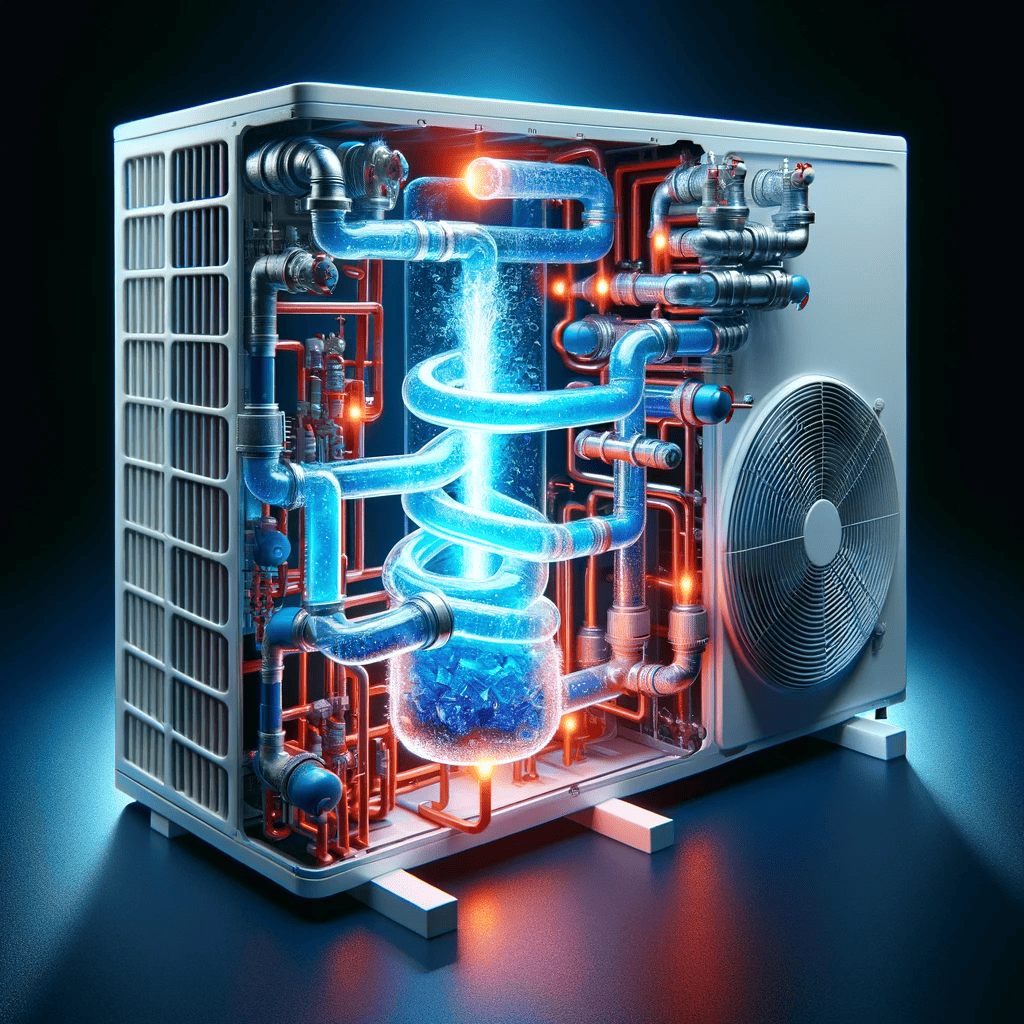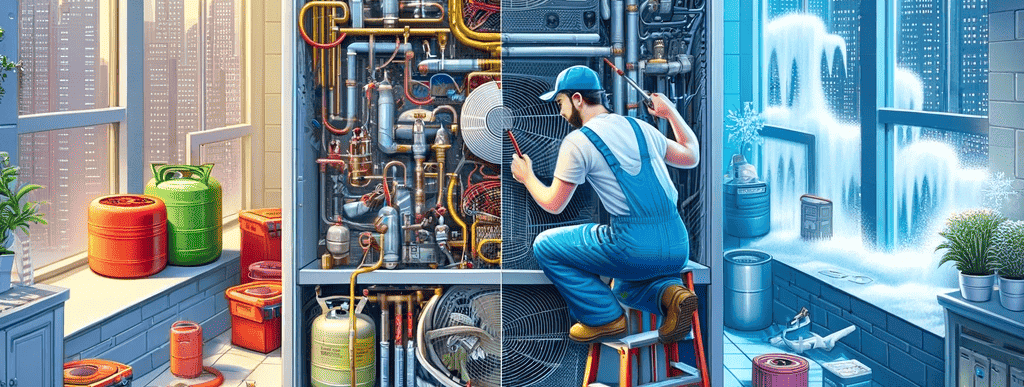Refrigerant Basics: Comprehensive Ductless Mini Split Installation Explained
The term 'refrigerant' plays a crucial role in the installation and functioning of a ductless mini split system. This glossary entry will delve into the intricacies of refrigerant, its role in ductless mini split systems, and the steps involved in its installation. Understanding the concept of refrigerant and its application in ductless mini split systems is vital for both professionals in the HVAC industry and homeowners considering this type of air conditioning system. This comprehensive guide aims to provide an in-depth understanding of the subject.
Table of Contents:

Refrigerant: Ductless Mini Split Installation Explained
There are several types of refrigerants used in air conditioning systems. The most common types include Chlorofluorocarbons (CFCs), Hydrochlorofluorocarbons (HCFCs), and Hydrofluorocarbons (HFCs).
Understanding Refrigerant
The term 'refrigerant' refers to a substance or mixture used in a heat pump and refrigeration cycle. In most cycles, it undergoes phase transitions from a liquid to a gas and back again. These phase transitions absorb or release heat, allowing for heating and cooling. Refrigerants have various properties that may make them more or less desirable for specific applications. Some of these properties include non-corrosiveness, non-flammability, and environmental friendliness. The choice of refrigerant can significantly impact the performance and efficiency of a ductless mini split system.
Types of Refrigerants
There are several types of refrigerants used in air conditioning systems. The most common types include Chlorofluorocarbons (CFCs), Hydrochlorofluorocarbons (HCFCs), and Hydrofluorocarbons (HFCs). Each type has its advantages and disadvantages, which can influence their suitability for specific applications. For instance, CFCs, such as R12, were widely used in the 20th century but have been phased out due to their high ozone depletion potential. HCFCs, such as R22, have a lower ozone depletion potential but are still harmful to the environment and are being phased out in many countries. HFCs, such as R410A and R32, are currently the most commonly used refrigerants as they do not deplete the ozone layer, although they do contribute to global warming.
Role of Refrigerant in Ductless Mini Split Systems
In a ductless mini split system, the refrigerant plays a crucial role in the heat exchange process. The system's outdoor unit compresses the refrigerant, raising its temperature and pressure. The refrigerant then travels to the indoor unit, where it releases its heat and cools down, before returning to the outdoor unit to repeat the process. This continuous cycle of compression, heat release, and cooling allows a ductless mini split system to provide efficient heating and cooling. The refrigerant is the medium that carries the heat from one place to another, making it a vital component of these systems.
Installation of Refrigerant in Ductless Mini Split Systems
The installation of refrigerant in a ductless mini split system is a complex process that requires professional knowledge and skills. It involves several steps, including the installation of the indoor and outdoor units, the connection of the refrigerant lines, and the charging of the system with refrigerant. It's important to note that the installation process can vary depending on the specific model of the ductless mini split system and the type of refrigerant used. Therefore, it's always recommended to follow the manufacturer's instructions or hire a professional to ensure a correct and safe installation.
Installation of Indoor and Outdoor Units
The first step in the installation process is to install the indoor and outdoor units. The indoor unit should be installed in a suitable location inside the house, usually high on a wall or on the ceiling. The outdoor unit should be installed outside the house, in a location where it can easily expel heat. Both units should be securely mounted and connected to a power source. It's also important to ensure that the outdoor unit is installed on a level surface and that there is sufficient space around it for proper airflow.
Connection of Refrigerant Lines
Once the indoor and outdoor units are installed, the next step is to connect the refrigerant lines. These lines are usually made of copper and are insulated to prevent heat loss. They are responsible for carrying the refrigerant between the indoor and outdoor units. The refrigerant lines must be connected correctly to prevent leaks and ensure efficient operation. This involves cutting the lines to the correct length, flaring the ends, and connecting them to the units using flare nuts. The connections should then be checked for leaks before proceeding to the next step.
Charging the System with Refrigerant
The final step in the installation process is to charge the system with refrigerant. This involves connecting a refrigerant cylinder to the system and allowing the refrigerant to flow into the system until the correct pressure is reached. It's important to note that the amount of refrigerant needed can vary depending on the length of the refrigerant lines and the specific model of the system. Overcharging or undercharging the system can lead to inefficient operation and potential damage, so this step should be carried out with care.

Importance of Proper Refrigerant Installation
The proper installation of refrigerant in a ductless mini split system is crucial for several reasons. Firstly, it ensures the efficient operation of the system. If the refrigerant is not properly installed, the system may not be able to provide sufficient heating or cooling. Secondly, proper installation prevents damage to the system. If the refrigerant lines are not properly connected, it can lead to leaks, which can damage the system and potentially lead to costly repairs.
Environmental Considerations
Proper refrigerant installation is also important from an environmental perspective. As mentioned earlier, some types of refrigerants can harm the environment if they are released into the atmosphere. Therefore, it's crucial to ensure that the installation process does not lead to refrigerant leaks. Furthermore, the use of environmentally friendly refrigerants is becoming increasingly important. Many manufacturers are now using HFCs, which do not deplete the ozone layer, and some are even starting to use natural refrigerants like CO2 or hydrocarbons, which have a lower global warming potential.
Legal Considerations
In many countries, there are laws and regulations governing the installation and handling of refrigerants. These laws are designed to protect the environment and ensure the safe operation of air conditioning systems. Therefore, it's important to be aware of these laws and to ensure that the installation process complies with them. For example, in the United States, the Environmental Protection Agency (EPA) requires technicians who install and service air conditioning systems to be certified. This certification ensures that technicians have the necessary knowledge and skills to handle refrigerants safely and responsibly.
Conclusion
In conclusion, the role of refrigerant in a ductless mini split system is crucial. It's the medium that carries heat from one place to another, allowing the system to provide heating and cooling. The installation of refrigerant is a complex process that requires professional knowledge and skills, and it's crucial for the efficient operation of the system and for environmental protection. Whether you're a professional in the HVAC industry or a homeowner considering a ductless mini split system, understanding the concept of refrigerant and its application in these systems can be very beneficial. It can help you make informed decisions and ensure that your system is installed correctly and operates efficiently.
Understanding the importance of refrigerant in your ductless mini split system is just the beginning. At RIchair Comfort, we bring our commitment to quality and exceptional customer service to every installation and service we provide. Since 1994, we've been at the forefront of offering efficient, comfortable, and environmentally friendly ductless technology to our customers. Don't leave the performance of your mini split system to chance. ? Interested in Reliable Maintenance? Schedule your service with RIchair Comfort today and experience the difference that expertise and dedication make.
Back Home - Richair Comfort Solution - Ductless Mini Split Systems Top Quality Installations and Professional Service.
Was This Article Helpful?
RECENT POSTS

